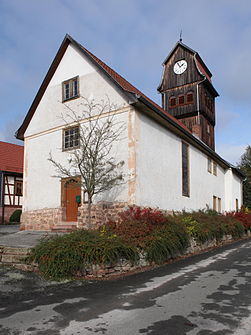Helmers (Schmalkalden)
|
Helmers
City of Schmalkalden
Coordinates: 50 ° 43 ′ 28 ″ N , 10 ° 17 ′ 40 ″ E
|
|
|---|---|
| Height : | 309 m above sea level NN |
| Residents : | 235 (2012) |
| Incorporation : | April 9, 1994 |
| Incorporated into: | Wernshausen |
| Postal code : | 98574 |
| Area code : | 036848 |
|
Location of Helmers in Schmalkalden
|
|
|
Protestant church
|
|
Helmers is a district of the city of Schmalkalden in the district of Schmalkalden-Meiningen in Thuringia .
geography
Helmers is the westernmost part of the city of Schmalkalden. The district is located in the Rosatal west of Wernshausen .
The district is heavily interspersed with slopes and rain, followed by forest on the steep slopes and mountains. A typical forest village, which once supported carter traffic.
history
The village of Helmers was first mentioned in documents in 1340. At that time the place belonged to the Office Frankenberg (later called Office Frauenbreitungen) in the county of Henneberg - Schleusingen , whose official seat, Castle Frankenberg , was near Helmers.
Helmers was persecuted by witches from 1613 to 1675: three women and a man were involved in witch trials , two people were burned, two died under torture and in dungeon. The first victim was Margaretha, Hans Kesselring's wife, burned in Frauenbreitungen in 1613.
From 1680 Helmers belonged to the Duchy of Saxony-Meiningen as part of the Frauenbreitungen office . From 1920 the place was in the state of Thuringia. From 1952 to 1990 it belonged to the Suhl district and since 1990 it has belonged again to Thuringia.
1994 Helmers was incorporated into Wernshausen. In December 2008, Wernshausen was voluntarily incorporated into Schmalkalden.
traffic
Helmers is located on Landesstraße 1026 between Georgenzell and Wernshausen. This road was once a trade route from Frankfurt am Main via Schmalkalden to Erfurt .
Culture and sights
- The Protestant branch church is a small half-timbered hall (marked 1672). The wooden roof tower with a mansard roof is from 1908. The interior was renovated in the 1980s. The furnishings are simply baroque , the hall contains a gallery .
- The former trade route was the reason for the construction of Frankenberg Castle . With her, Helmers took over the supervision of this trade route, with the mountain farmers supporting the travelers. The castle complex, which was probably built around 1200, was the ancestral seat of the Lords of Frankenberg . After the destruction in the Peasants' War , the remains of the wall of the palace and the 24 m high keep are still preserved. This consists of sandstone humpback blocks with pincer holes, the original entrance is on the west side at a height of 11 m.
- A riding stables as a broad, two-storey half-timbered building probably dates from the 16th century, but later changed. It is decorated with protruding storeys, crossed struts, curved foot struts, a frame and gable trapezoid with ship throats.
Web links
Individual evidence
- ^ Wolfgang Kahl : First mention of Thuringian towns and villages. A manual. 5th, improved and considerably enlarged edition. Rockstuhl, Bad Langensalza 2010, ISBN 978-3-86777-202-0 , p. 117.
- ↑ Kai Lehmann : Innocent. Witch hunt south of the Thuringian Forest. Over 500 researched cases from the 16th and 17th centuries. Wehry-Verlag, Untermaßfeld 2012, ISBN 978-3-9813902-8-5 , p. 125 f .; Kai Lehmann: Exhibition "Luther and the Witches". Helmers area, Library Museum Schloss Wilhelmsburg Schmalkalden, 2012; Ronald Füssel: The persecution of witches in the Thuringian area (= publications of the working group for historical witchcraft and crime research in Northern Germany. Vol. 2). DOBU-Verlag, Hamburg 2003, ISBN 3-934632-03-3 , p. 236 and p. 247, (also: Marburg, Universität, Dissertation, 2000).
- ↑ a b c Stephanie Eißing et al.: Thuringia (= Handbook of German Art Monuments . ). Revision. 2nd, revised and supplemented edition. Deutscher Kunstverlag, Munich 2003, ISBN 3-422-03095-6 , p. 595.
- ↑ Michael Köhler: Thuringian castles and fortified prehistoric and early historical living spaces. Jenzig-Verlag Köhler, Jena 2001, ISBN 3-910141-43-9 , p. 102.

